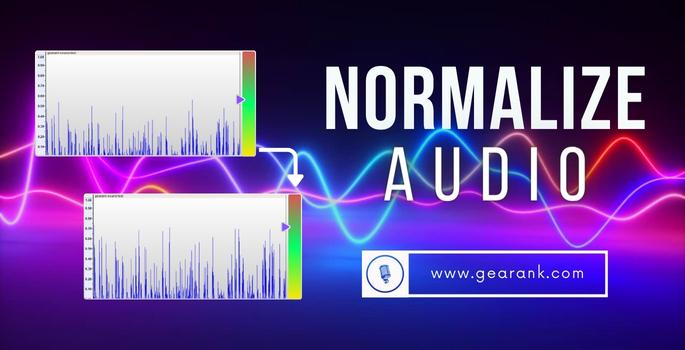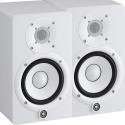Why Normalize Audio? Bringing Balance To An Audio Clip

Normalize AudioAudio Normalization increases the volume levels of digital audio tracks without altering its tone and dynamic range. Normalization modifies the waveform data of the track, instead of merely adjusting the volume. |
Audio normalization is a fundamental technique used in digital audio processing that adjusts a sound signal's amplitude to a desired level without introducing any distortion. Knowing how to normalize audio is particularly useful in fixing recordings and audio files and preparing audio tracks for mastering.
For professionals in the music industry, such as music producers and audio engineers, it is essential to have a thorough understanding of when and how to use audio normalization effectively.
Fortunately, the process of audio normalization is relatively straightforward and can be broken down into its constituent parts, including what is audio normalization, why it is necessary, when to apply it, and how to perform it.
To better understand audio normalization and its role in digital audio processing, we have provided a comprehensive guide covering all aspects of the technique, from its basic principles to advanced applications.
What is Audio Normalization?
Audio normalization is increasing the volume level of a digital audio track without altering its dynamic range. Unlike simply adjusting the volume in a DAW, normalization alters the waveform data of the track. This technique applies to recorded audio, created, and saved as a digital audio file.
Normalization can be beneficial for quiet recordings with small waveforms as it can increase the volume and size of the waveform to peak level, which is ideal for mixing and listening purposes.
Normalization generally works by boosting the loudest part of the audio track to a specific dB value, thereby strengthening your audio signals.
This technique increases the average volume of the track without distorting the dynamics or introducing unwanted distortion.
Peak Normalization vs Loudness Normalization
Two types of audio normalization are used to edit audio files: peak normalization and loudness normalization.
-
Peak normalization is a technique that boosts the highest peak value (the loudest part) of an audio file to 0dB, which is the maximum volume that a peak amplitude can reach before "clipping." Clipping distorts audio, so it's important to avoid it. This technique is simple and effective for audio files with consistent dynamic range, but there may be better options for files with fluctuating dynamic range.
-
Loudness normalization is a complex form of audio normalization that considers loudness volume detection, human hearing, and perceived loudness. It is implemented by digital streaming services to provide consistent volume levels for listening audiences. It is based on RMS volume detection and EBU R 128 and aims to ensure the audio levels are balanced and consistent across different tracks.
The most frequently used type of normalization in music production is peak normalization.
Why Normalize Audio?
Audio normalization is used to make a quiet audio file sound louder without affecting its dynamics or tonality. Normalizing the audio brings up the overall volume to a suitable signal level.
This process is beneficial when mixing tracks, as quiet recordings can introduce various issues.
For instance, the audio level might need to be louder to be heard in the mix, making it harder to mix and edit. In extreme cases, quiet recordings may be unusable.
Normalization amplifies the volume of the audio file itself, providing a healthy signal for use at the mixing stage.
It is used in music production and by streaming services and platforms for broadcast audio and commercial listening.
Normalizing music and video audio guarantees that the sound plays at a consistent volume level on headphones or a digital audio system, eliminating the need for audiences to adjust playback volume constantly.
When You Should Use Normalization
Normalization is a technique used to increase the volume of an audio file through digital processing.
There are two common scenarios in which normalization is applied: processing recordings and mastering tracks.
In both cases, the goal is to ensure that the audio reaches the desired loudness level without introducing distortion or clipping.
Normalization achieves this by adjusting the gain of the audio signal based on its peak level, bringing it up to the maximum level possible without causing any audio artifacts.
Normalizing in Recordings
When audio recordings have different volume levels, normalization can be used as a quick and efficient solution to bring them to a consistent and healthy level.
This is particularly useful in multitrack recording, where multiple files may have been recorded with different volumes.
Normalizing the audio recordings helps to increase the volume of the quieter tracks, resulting in an easier to balance mix.
Normalization ensures that all recordings have a consistent volume level for easier sound mixing.
Normalizing in Mastering
Normalization is a technique used in mastering audio tracks, the final step in preparing a song for commercial release. Normalization is applied to the entire track to raise the volume to a particular target level during mastering.
Other mastering procedures, such as equalization and compression, follow this process. The current trend in mastering audio tracks is to achieve peak volume, which has led to a debate in the music industry regarding whether maximizing amplitude is more desirable than preserving the natural dynamic range of the audio. This phenomenon is known as the "loudness war."
How to Normalize Audio
When it comes to normalizing audio files, the process is quite simple and can be done even if multiple tracks need to be set at the same volume level.
Most audio editing software, such as Adobe Audition, allows you to normalize a digital recording or audio track quickly.
Open the digital audio file, or files, in the audio editor and look for the software's normalization tool. You can use this to set the same amount of volume for different tracks.
Once you locate the tool, you can edit parameters such as selecting a target dB level or individually normalizing stereo channels. You may also use presets if you prefer.
After applying the normalization process, you will notice an increase of gain in the audio track's volume, increasing the waveform's thickness. All you need to do at this point is save the processed track as a new file.
The Advantages and Disadvantages of Normalizing Audio
Normalization is a technique that has its own set of advantages and disadvantages. The effectiveness of this technique is based on its usage and the quality of the input audio tracks.
One of the major benefits of normalization is that it can boost the volume of a low-level recording, making it conducive for mixing.
However, normalization can also amplify unwanted sounds and noise if the audio recording is excessively quiet due to incorrect gain staging.
The Advantages of Normalizing Audio
-
Increasing the volume of quiet recordings so that the audio sounds louder and clearer
-
Processing multiple audio files to the same peak level - useful for multiple recordings and songs that require a consistent level for mixing or general listening
-
Matching volumes of individual channels of a stereo track if one channel is quieter
-
Increasing the volume of a mixdown to a specific target level at the mastering stage
The Disadvantages of Normalizing Audio
-
Increasing the volume of noise - especially when the audio is too quiet (bad signal-to-noise ratio)
-
Increasing the volume of unwanted background noise that might be present in recordings
-
Proving ineffective if the audio clip has an excessively loud part, in which case normalization can normalize peak amplitude and not make an audible difference
-
Normalizing audio during mixing can affect plugins that were already set. For compressors, this might cause unintentional audio ducking
Conclusion
Audio Normalization is an essential audio processing technique that can enhance the quality of audio tracks, particularly recordings with low volume levels. When you normalize audio, the volume can be increased to a more suitable dB level, making it easier to process and mix the audio further.
Be aware that normalizing audio can also increase the volume of noise and unwanted sounds in recordings, especially if the audio is too quiet. Therefore, it's crucial to carefully scrutinize audio tracks for any background sounds or noise before normalizing them.
Contributors:
- Alexander Briones - Editor
- Jerry Borillo - Illustrator












